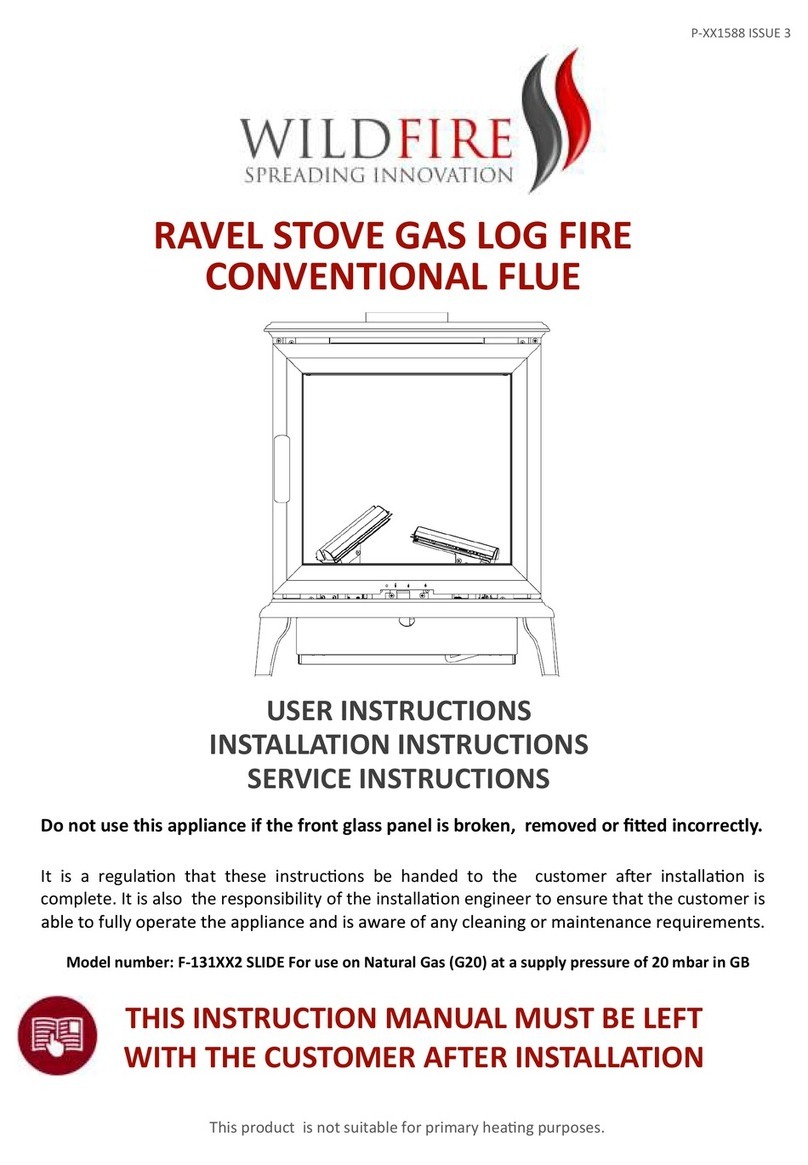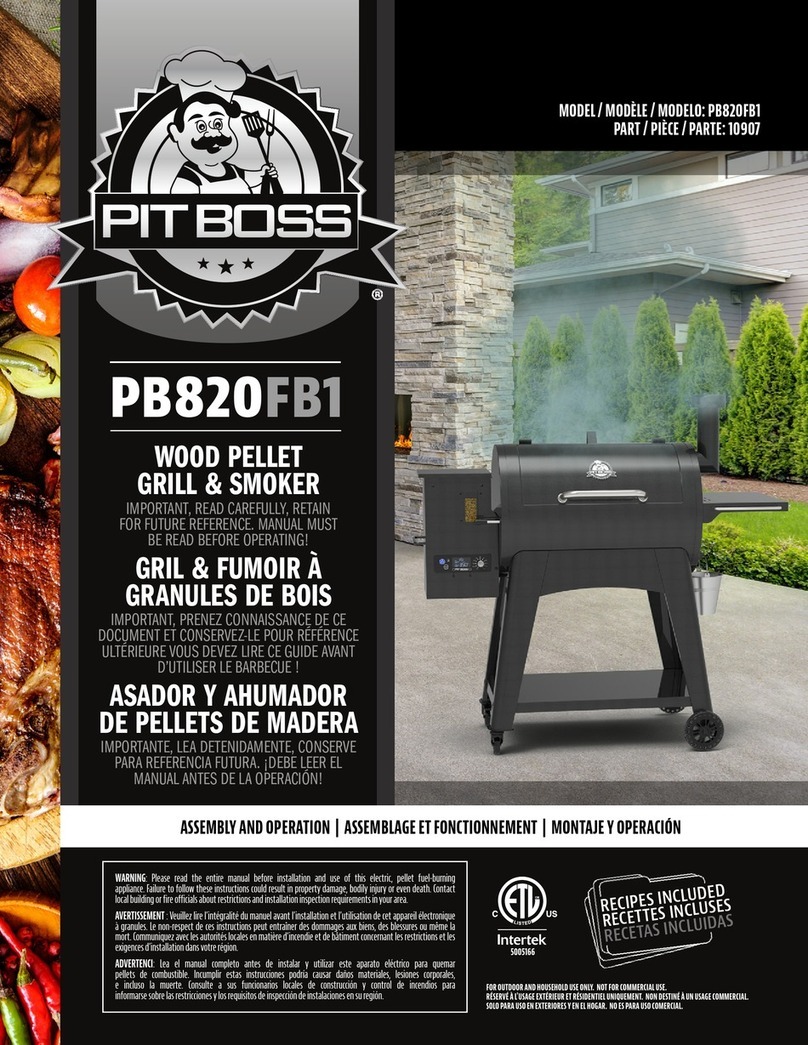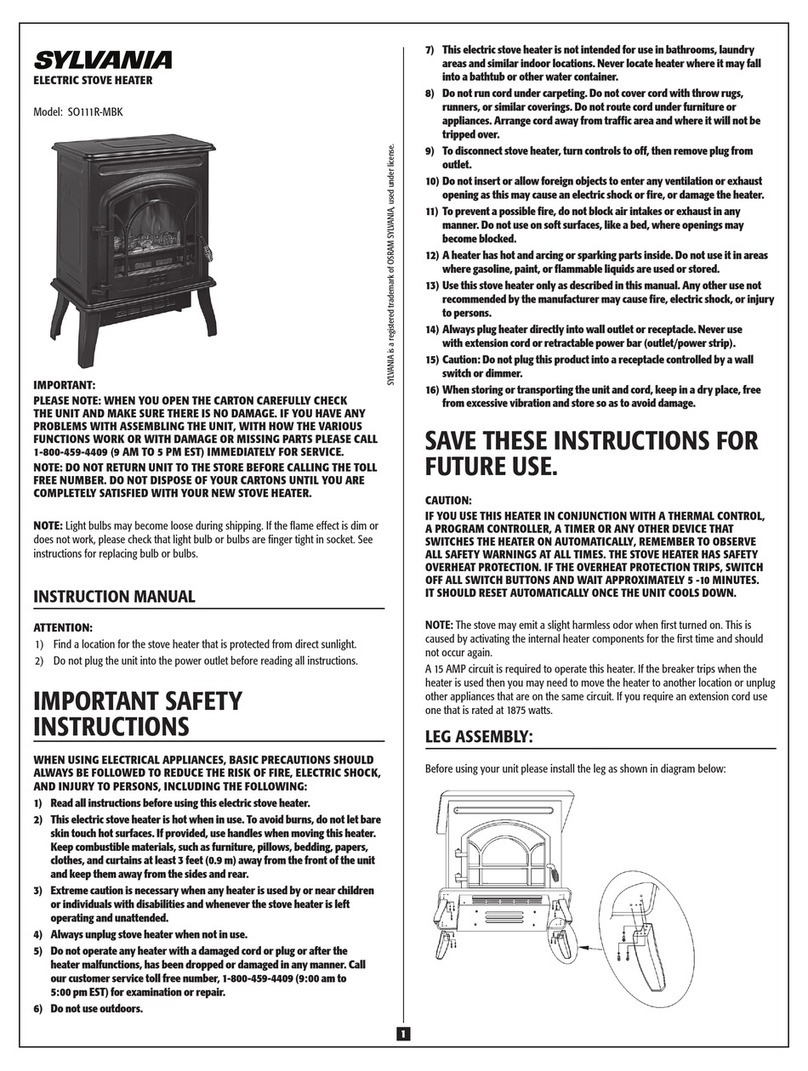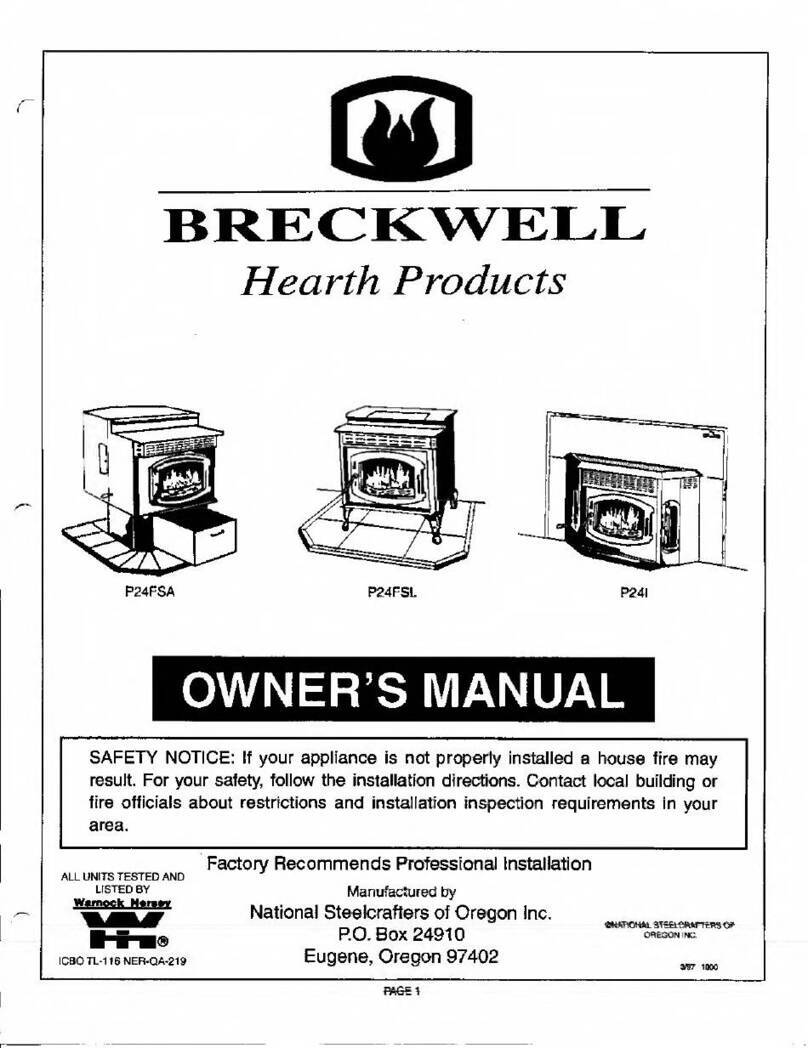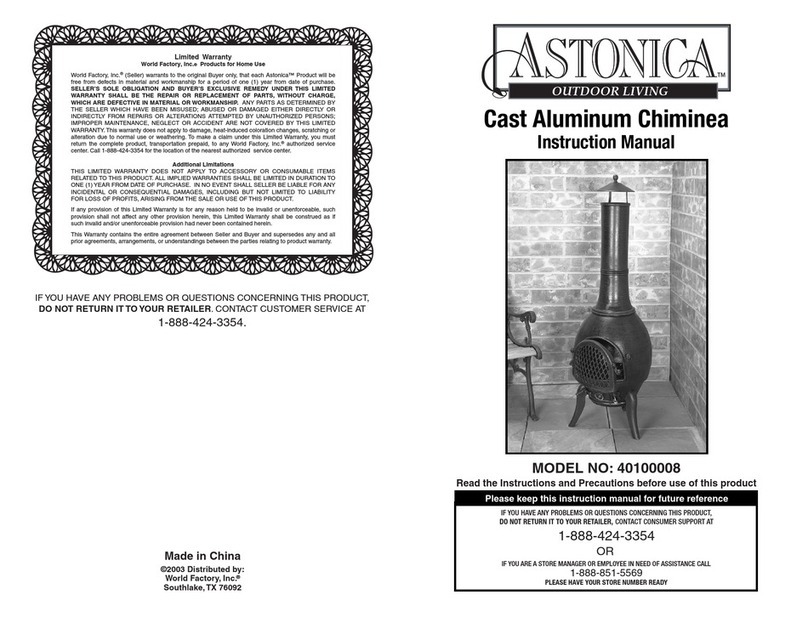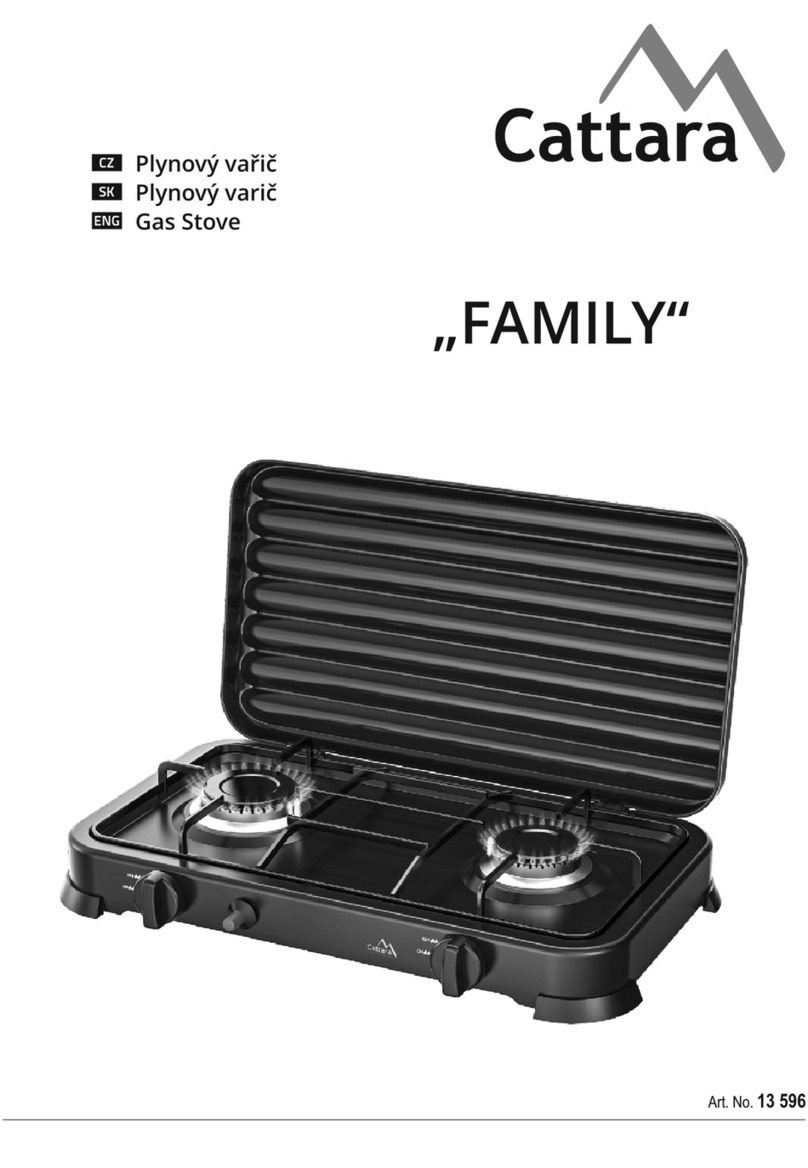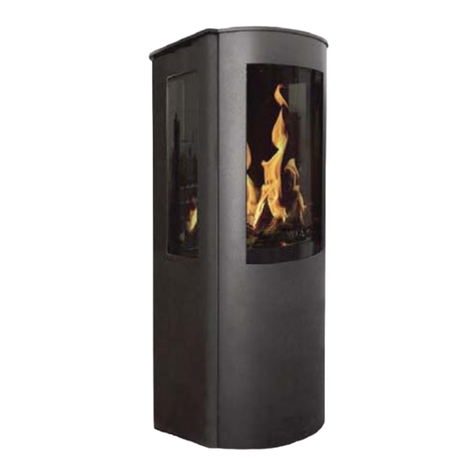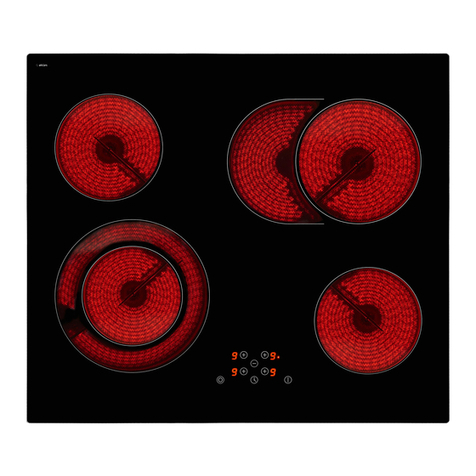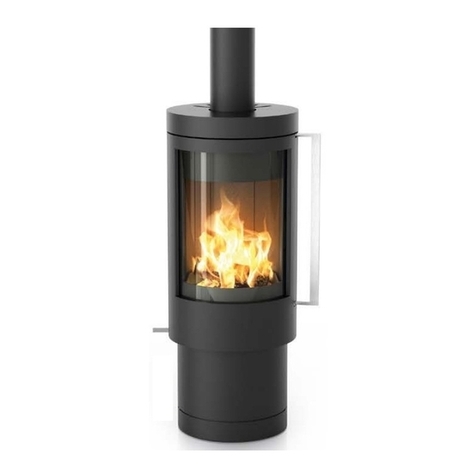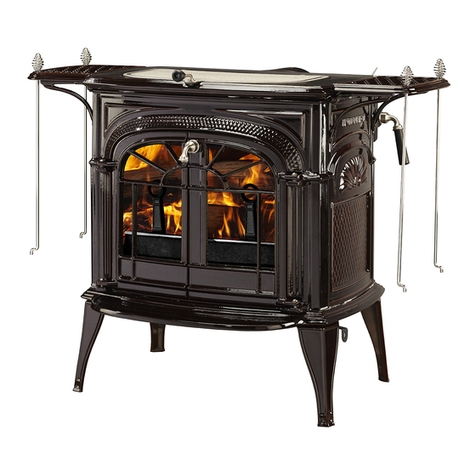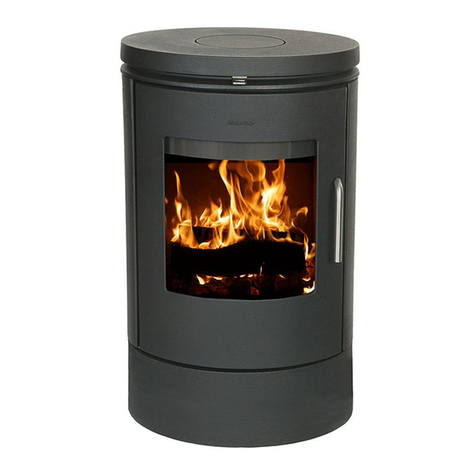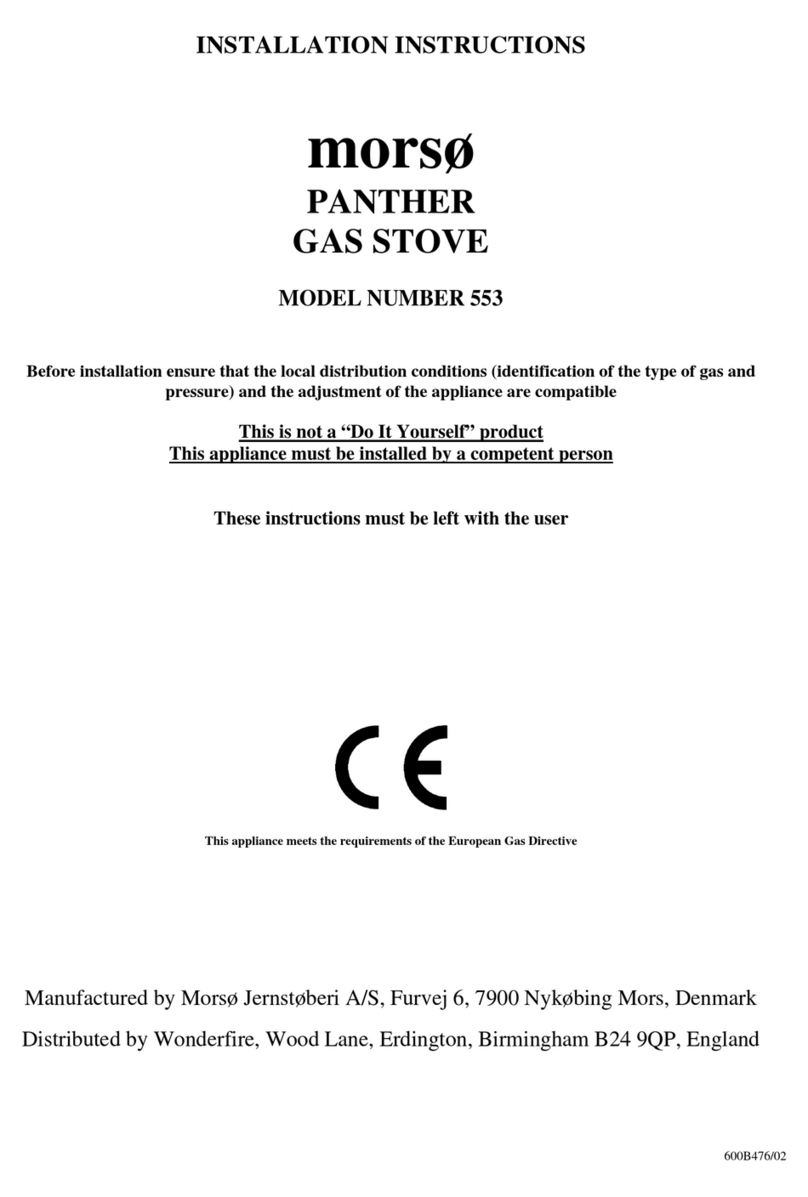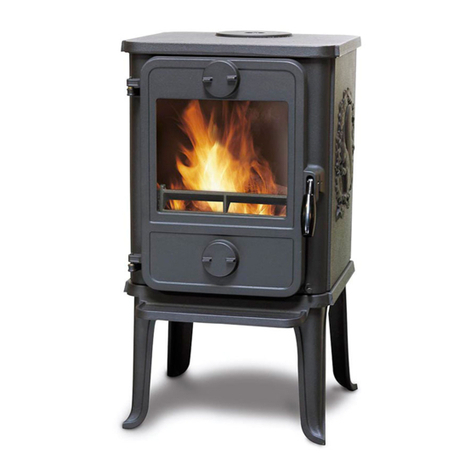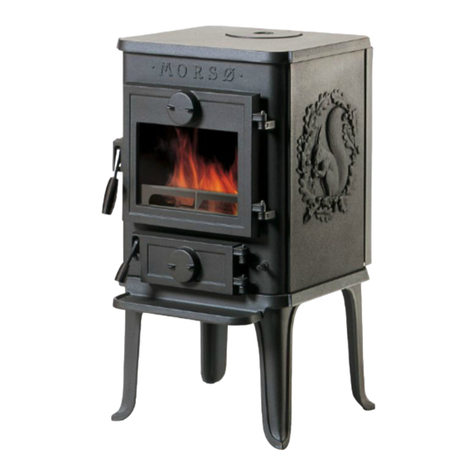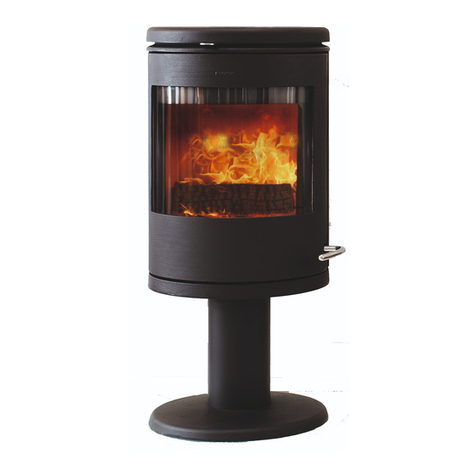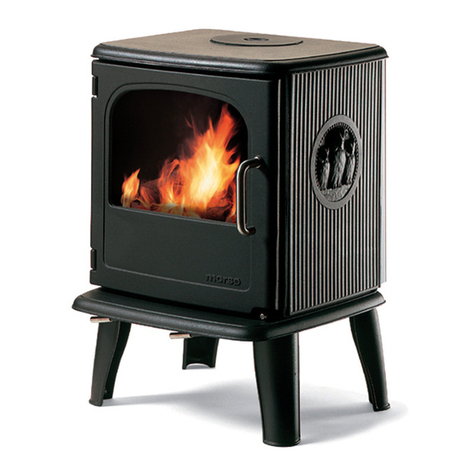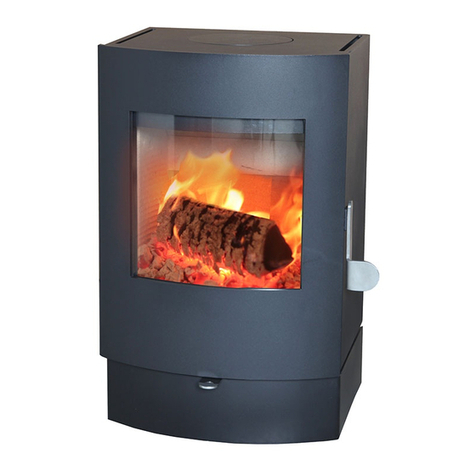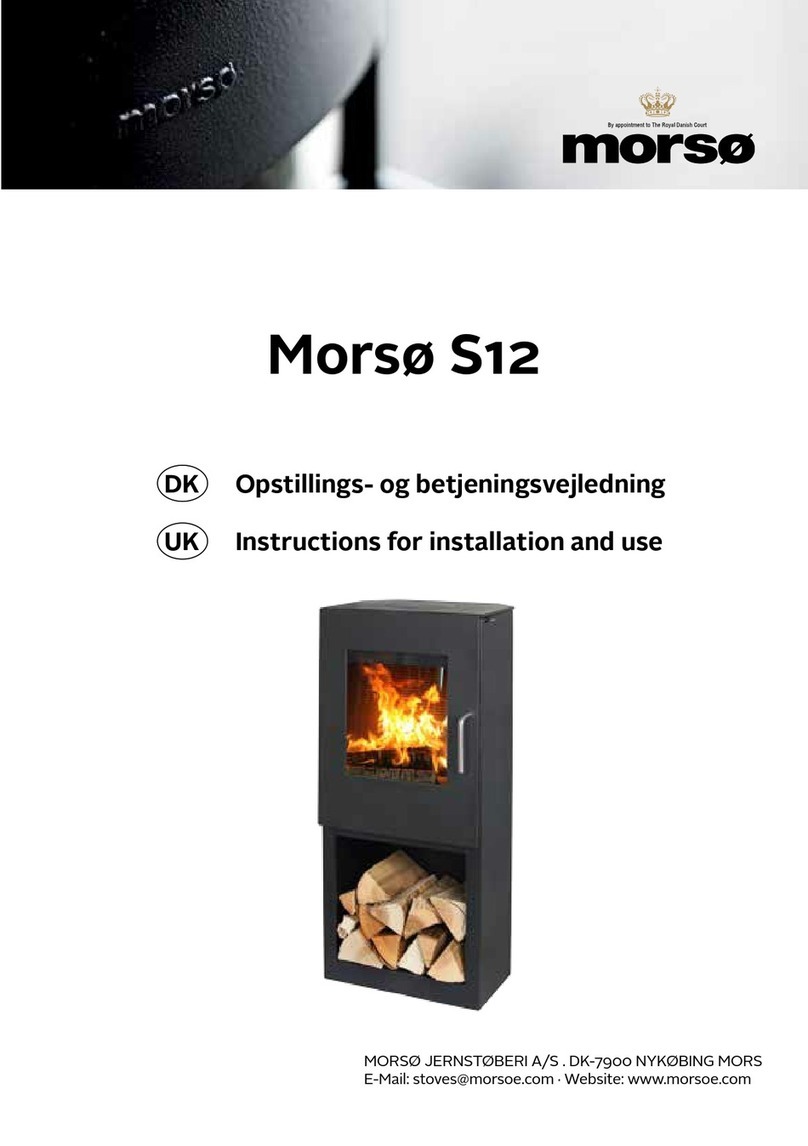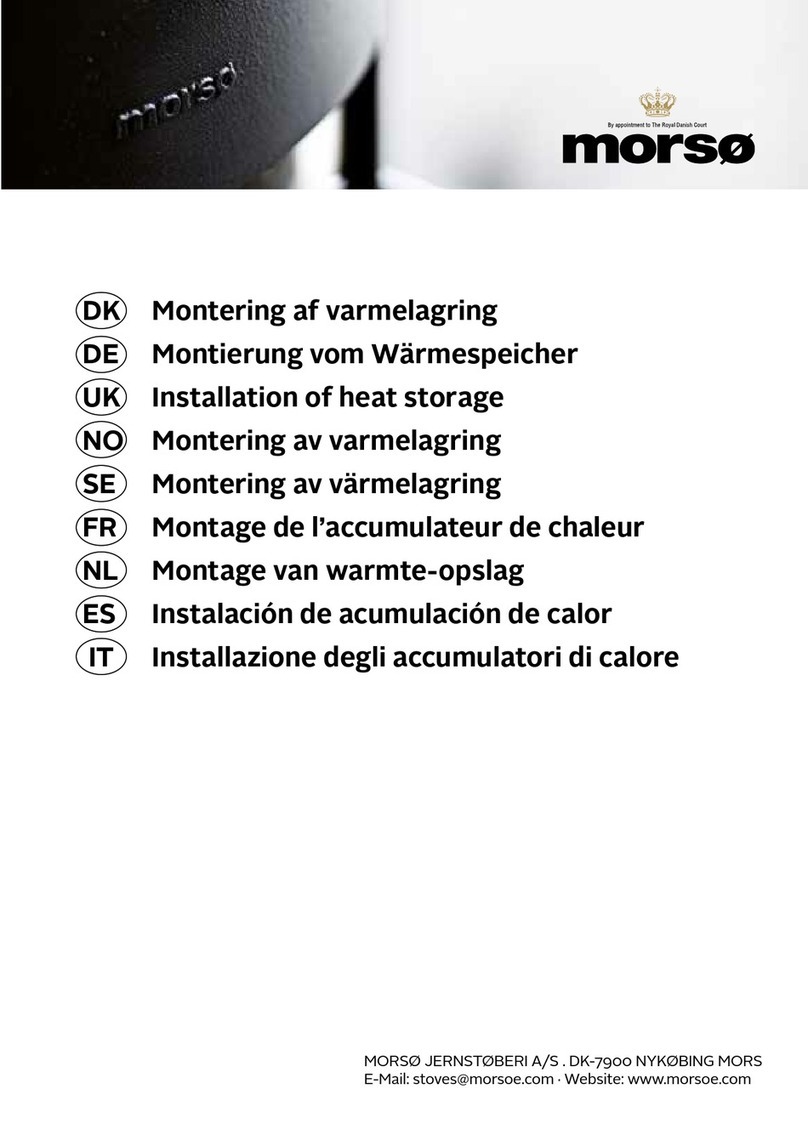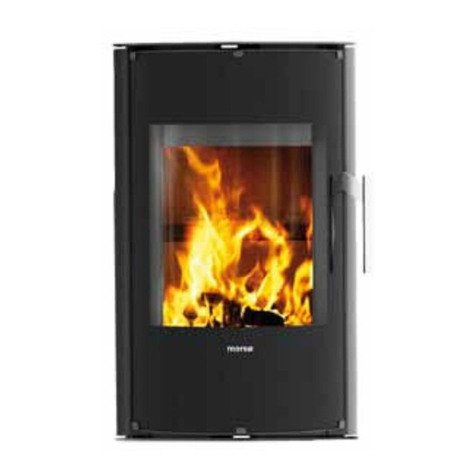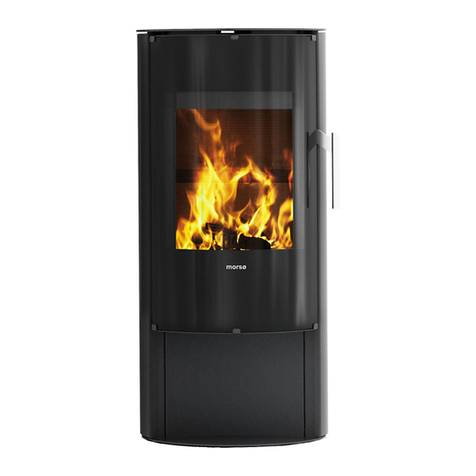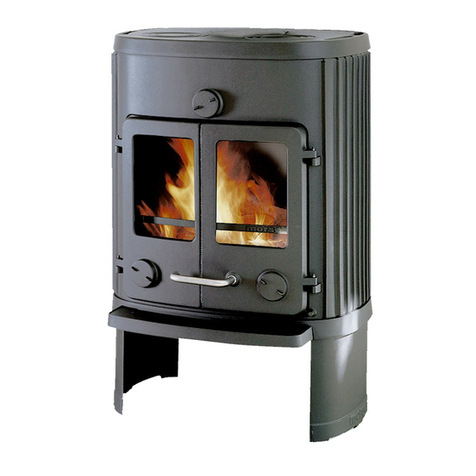
DB15 INSTALLATION AND OPERATING INSTRUCTIONS
DB15 INSTALLATION AND OPERATING INSTRUCTIONS
HOW THE DB15 WORKS
The Morsø DB15 is a ‘downburn’
stove where the waste gases
pass down through the fire bed
and into the ’afterburn’ chamber
(A) reaching temperatures
of 1000ºC at the back where
the smoke is burned away.
This system gives very clean
combustion and extremely
high efficiency on a wide range
of fuels.
LIGHTING If lighting after a
period of non-use, do check
that the flueways and chimney
are completely clear. Place
two or three firelighters close
together, or screwed-up paper
covered with dry kindling, at the
back of the grate and light them.
When they are burning well
gently fill the fire with dry fuel.
Downburn stoves ignite very
quickly, but they begin to burn
at the back, so the full flame
may not be apparent for a
few minutes.
STOKING Don’t fill to the
point where fuel touches roof
of the stove.
CONTROL Correctly installed
(see page 10) this stove will
control itself for minimum
fuel consumption. The manual
control on the top of the
door overrides the automatic
control. It can be helpfully
used when first lighting or
refuelling, but keep it shut,
or nearly so, in normal use.
The Thermostat Dial on
the lower right of the stove
controls a device which senses
the temperature of water in
the boiler and automatically
allows air in to make the fire
burn more or less fiercely,
so that water always leaves
the boiler at about 50ºC on the
lowest setting to about 90ºC
at the highest. Once you have
found the most appropriate
setting for your house -
usually about midway -
it shouldn’t be necessary to
adjust it again. To adjust
the house temperature, adjust
the radiator thermostats
(if fitted) or your central room
thermostat. These controls
will then automatically limit
or allow the flow of water
through the boiler, which will
adjust itself accordingly. Your
fire will die down or flare up
and the central heating pump
go on or off as needed in
response to the temperature
of rooms and water. When you
adjust the central controls,
wait an hour or two for the
adjustment to ‘stabilise’ -
controls are deliberately made
to react slowly to prevent rapid
on-off-on-off cycling.
EMPTYING ASHES If you’re
using mineral fuels like anthracite
or manufactured smokeless
fuels - then empty the ash
regularly, if it builds up it will
severely damage the grates.
If you mainly use wood, then
do the opposite, let the ash and
charcoal build up. To empty
the ash agitate the firebed
by using the tool to operate
the riddling mechanism on
the right-hand side. Use the
ashpan tool to remove the
ashpan. Remember to let ash
cool before disposing in plastic
sacks or dustbins. There is
no need to empty every last
speck, but ash from mineral
fuels (coal etc) should never
be allowed to build up so that
it comes into contact with the
underside of the grate
EXTENDED BURNING Allow
the fire to burn down to a low,
hot firebed. Empty the ash,
fully fill with hard fuel such
as anthracite and your stove
can burn for up to twelve
hours without attention.
KEEPING THE WINDOW CLEAN
Reduce the risk of staining by
using only very dry fuel. Severe
stains can be removed when
cold with Morsø glass cleaner.
DO NOT use proprietary solvent-
based stove window cleaners.
The window is not glass but a
transparent ceramic, when
using some solid fuels it may
develop tiny hairline surface
cracks, these are harmless,
and a known characteristic of
some mineral fuels.
OPENING THE DOOR
This stove is designed to be
operated only with the door
closed. Open the door very slowly
to minimise fume emission and
prevent hot fuel falling out.
SUMMER SHUT DOWN
Before a long period of non-use,
empty fuel and ash and leave
all the air controls open and the
door slightly ajar to allow ventilation
to reduce condensation.
GUARD AGAINST CONDENSATION!
Solid fuels contain water which can condense on cool boiler faces to cause
rapid corrosion and failure. Always fit a device such as a low-level thermostat to
minimise cool water circulating through the boiler. ALLOW FOR OVERHEATING!
This boiler has automatic control, but there must be some way of dissipating
surplus heat - fit a high-level thermostat to override controls and run the central
heating if there is risk of boiling. Follow the rules given in this instruction booklet.
An old-fashioned ‘heat leak’ radiator will not suffice.
LIVING WITH YOUR STOVE Every fuel, chimney and condition of use is different.
Only experience will show which are the best settings for you.
FITTING Fit the flue collar to the top of the stove and seal to the chimney using a short length
of uninsulated pipe. Two possible ways of doing this are shown below.
Whichever method is used it is imperative that the route for gases from the stove to
the chimney terminal is completely air-tight; even the tiniest gap or crack can spoil the
updraught. Seal all joins with fireproof cement and/or heatproof rope.
HEATING SYSTEM DESIGN This appliance is for use with an open-vented water heating circuit
at a maximum pressure of 2 Bar, equivalent to a static head of 18 metres. Suggested circuit
designs are given on page 10 & 11.
IMPORTANT! CHECK THE INSTALLATION!
Once installed check that:
1) The route for gases from the stove to the chimney terminal is completely airtight,
unobstructed and able to be swept. (access hatches may be required.)
2) The entire fireplace construction is of durable non-combustable materials
3) The flue presents a draught in use of at least 12Pa
5) A CO alarm is fitted
6) Flue data plate is completed and fixed in the fireplace recess or utility cupboard
7) The water system can never exceed 2 Bar pressure, has provision to dissipate or store
surplus heat, can accommodate boiling, and has means to minimise the circulation of cool
water through the boiler
8) Light stove and ensure it burns controllably and does not emit fumes to the room
9) Demonstrate the operation of the stove to the householder
LIVING WITH YOUR STOVE
Every fuel, chimney and condition of use is different. Only
experience will show which are the best settings for you.
HOW THE DB15 WORKS: The Morso DB15 is a 'downburn' stove
where the waste gases pass down through the hot fire and into an
'afterburn' chamber (A) at the back where even smoke is burned
away. This system gives very clean combustion and extremely
high efficiency on a wide range of fuels.
LIGHTING If lighting after a period of non-use, do check that the
flueways and chimney are completely clear. Empty the ashes if
need be. Place two or three firelighters close together, or screwed-
up paper covered with dry sticks, at the back of the grate and light
them. When they are burning well
gently fill the fire with dry fuel.
Downburn stoves ignite very
quickly, but they begin to burn at
the back, so the full flame may not
be apparent for a few minutes.
FILLING: (C) Don't fill to the point
where fuel touches roof of the
stove.
CONTROL. Correctly installed
(see separate sheet) this stove
will control itself for minimum fuel
consumption.
The manual control on the top of
the door overrides the automatic
control. It can be helpfully used
when first lighting or refuelling, but
keep it shut, or nearly so, in normal use.
The Thermostat Dial on the lower right of the stove controls a
device which senses the temperature of water in the boiler and
automatically allows air in to make the fire burn more or less
fiercely, so that water always leaves the boiler at about 50ºC on
the lowest setting to about 90ºC at the
highest. Once you have found the most
appropriate setting for your house - usually
about midway - it shouldn't be necessary to
adjust it again. To adjust the house
temperature, adjust the radiator thermostats
(if fitted) or your central room thermostat.
These controls will then automatically limit or
allow the flow of water through the boiler,
which will adjust itself accordingly. Your fire
will die down or flare up and the central
heating pump go on or off as needed in response to the
temperature of rooms and water.
When you adjust the central controls, wait an hour or two for the
adjustment to 'bed in' - controls are deliberately made to react
slowly to prevent rapid on-off-on-off cycling.
EMPTYING ASHES. If you're using mineral fuels like anthracite or
manufactured smokeless fuels - then empty the ash regularly, if it
builds up it will severely damage the grates. If you mainly use
wood, then do the opposite, let the ash and charcoal build up. To
empty the ash agitate the firebed by using the tool to operate the
riddling mechanism on the right-hand side. Use the ashpan tool to
lift out the ashpan. Remember to let ash cool before disposing in
plastic sacks or dustbins. There is no need to empty every last
speck, but ash from mineral fuels (coal etc) should never be
allowed to build up so that it comes into contact with the underside
of the grate.
EXTENDED BURNING Allow the fire to burn down to a low, hot
firebed. Empty the ash, fully fill with hard fuel such as anthracite
and your stove can burn for up to twelve hours without attention.
KEEPING THE WINDOW CLEAN. Reduce the risk of staining by
using only very dry fuel. Severe stains can be removed when cold
with a domestic bleach cleaner. DO NOT use proprietary solvent-
based stove window cleaners. The window is not glass but a
transparent ceramic, it may develop tiny hairline cracks, these are
harmless, and a characteristic of the toughest and material known.
OPENING THE DOOR This stove is designed to be operated only
with the door closed. Open the door very slowly to minimise fume
emission and prevent hot fuel falling out.
SUMMER SHUT DOWN: Before a long period of non-use, empty
fuel and ash and leave all the air controls open to allow ventilation
to reduce condensation.
FUELS
The Morso DB15 is one of very few stoves which can burn almost
any solid fuel. But there is no 'perfect' fuel, so we strongly
recommend that you try a selection of fuels (or mixtures) to find
which suits you best. Do avoid dusty materials like sawdust, they
can burn far to violently.
SMOKE CONTROL: In certain
areas special rules apply to
reduce smoke nuisance. Check
with your local authority.
WOOD only emits as much
carbon to the atmosphere as the
tree took in when growing, so wood is considered the 'carbon
neutral' fuel. When wood is cut down its cells are full of water.
Burning such wet or 'green' wood wastes heat in making steam
and produces flammable, acidic tars which will cling to, and rapidly
damage, your stove and chimney. Split logs will typically take two
years to become reasonably dry, round logs very much longer.
Cracks in the ends, a hollow sound when tapped and bark falling
away are all signs that a log may be ready for use. The fine, white
residue produced when wood burns is not ash, but the remains of
cell walls which can burn if kept hot enough, so don't de-ash the
fire until absolutely necessary when using wood.
For best performance, and always for low smoke emission:
●Split logs lengthways for drying
●Use logs no bigger than about 100mm x 250mm
●Ensure logs are absolutely dry (less than 20% moisture)
●Fill the stove loosely, so air can circulate between logs.
●Fill 'little and often'
●When first lighting, or reviving a fire from embers, use only very
small, thin, dry, sticks.
●Keep a constant, deep, bed of charcoal and wood ash beneath
the burning logs. This may need several firings to build up.
JOINERY WASTE Dry wood offcuts will burn well, but don't expect
softwood waste to burn as cleanly or for as long as hardwood logs.
PEAT: Sod turf must be thoroughly dry.
LIGNITE or BROWN COAL is a natural mineral, between peat
and coal. It lights easily and burns well, but produces much ash.
BITUMINOUS COAL (Sold as 'Housecoal' or 'Polish') (does
NOT burn smokelessly, and is not permitted in smoke control
areas of the UK and RoI) is raw, natural coal containing a high
proportion of bitumen. The DB15 is one of very few stoves which
can burn this fuel with high efficiency. But be aware that It makes
lots of tarry smoke and large volumes of flammable gas which can
sometimes make it difficult to control.
ANTHRACITE is a natural hard, shiny form of coal. Slow to light, it
can burn for very long periods with great heat. Despite its high
price-per-bag it generally works out to be one of the cheapest of all
fuels. Use the 'small nuts' size.
COKE is coal from which the smoke has been removed.
Sometimes difficult to light, it burns very cleanly.
BRIQUETTES Are compressed blocks of fuel, generally able to
burn for long periods and remarkable for their consistency.
'Homefire' and 'Phurnacite' are smokeless types while other
brands are made from lignite, peat or housecoal.
PETROLEUM COKE sold as 'Petcoke', 'Longbeach' and other
names, is an industrial reagent made from oil sometimes simply
sold as 'smokeless fuel' without any brand designation and
identifiable by a structure of tiny cohered beads. Although the
DB15 can burn this fuel safely, it WILL rapidly degrade interior
parts.
HOUSEHOLD WASTES Some plastics give off toxic fumes when
burned and remember that batteries and aerosols explode! The
stove is not an incinerator, so only ever use the recommended
fuels and NEVER use liquid fuels in any form.
PROBLEMS?
Problems like those listed here are usually due to some difficulty
with the installation, chimney or fuels, so please check back
through this leaflet carefully. If necessary seek specialist advice.
SMOKE FROM THE CHIMNEY It is quite normal for a little smoke
3
Use radiator or
room thermostats to
control the system,
not the controls on
the stove
LIVING WITH YOUR STOVE
Every fuel, chimney and condition of use is different. Only
experience will show which are the best settings for you.
HOW THE DB15 WORKS: The Morso DB15 is a 'downburn' stove
where the waste gases pass down through the hot fire and into an
'afterburn' chamber (A) at the back where even smoke is burned
away. This system gives very clean combustion and extremely
high efficiency on a wide range of fuels.
LIGHTING If lighting after a period of non-use, do check that the
flueways and chimney are completely clear. Empty the ashes if
need be. Place two or three firelighters close together, or screwed-
up paper covered with dry sticks, at the back of the grate and light
them. When they are burning well
gently fill the fire with dry fuel.
Downburn stoves ignite very
quickly, but they begin to burn at
the back, so the full flame may not
be apparent for a few minutes.
FILLING: (C) Don't fill to the point
where fuel touches roof of the
stove.
CONTROL. Correctly installed
(see separate sheet) this stove
will control itself for minimum fuel
consumption.
The manual control on the top of
the door overrides the automatic
control. It can be helpfully used
when first lighting or refuelling, but
keep it shut, or nearly so, in normal use.
The Thermostat Dial on the lower right of the stove controls a
device which senses the temperature of water in the boiler and
automatically allows air in to make the fire burn more or less
fiercely, so that water always leaves the boiler at about 50ºC on
the lowest setting to about 90ºC at the
highest. Once you have found the most
appropriate setting for your house - usually
about midway - it shouldn't be necessary to
adjust it again. To adjust the house
temperature, adjust the radiator thermostats
(if fitted) or your central room thermostat.
These controls will then automatically limit or
allow the flow of water through the boiler,
which will adjust itself accordingly. Your fire
will die down or flare up and the central
heating pump go on or off as needed in response to the
temperature of rooms and water.
When you adjust the central controls, wait an hour or two for the
adjustment to 'bed in' - controls are deliberately made to react
slowly to prevent rapid on-off-on-off cycling.
EMPTYING ASHES. If you're using mineral fuels like anthracite or
manufactured smokeless fuels - then empty the ash regularly, if it
builds up it will severely damage the grates. If you mainly use
wood, then do the opposite, let the ash and charcoal build up. To
empty the ash agitate the firebed by using the tool to operate the
riddling mechanism on the right-hand side. Use the ashpan tool to
lift out the ashpan. Remember to let ash cool before disposing in
plastic sacks or dustbins. There is no need to empty every last
speck, but ash from mineral fuels (coal etc) should never be
allowed to build up so that it comes into contact with the underside
of the grate.
EXTENDED BURNING Allow the fire to burn down to a low, hot
firebed. Empty the ash, fully fill with hard fuel such as anthracite
and your stove can burn for up to twelve hours without attention.
KEEPING THE WINDOW CLEAN. Reduce the risk of staining by
using only very dry fuel. Severe stains can be removed when cold
with a domestic bleach cleaner. DO NOT use proprietary solvent-
based stove window cleaners. The window is not glass but a
transparent ceramic, it may develop tiny hairline cracks, these are
harmless, and a characteristic of the toughest and material known.
OPENING THE DOOR This stove is designed to be operated only
with the door closed. Open the door very slowly to minimise fume
emission and prevent hot fuel falling out.
SUMMER SHUT DOWN: Before a long period of non-use, empty
fuel and ash and leave all the air controls open to allow ventilation
to reduce condensation.
FUELS
The Morso DB15 is one of very few stoves which can burn almost
any solid fuel. But there is no 'perfect' fuel, so we strongly
recommend that you try a selection of fuels (or mixtures) to find
which suits you best. Do avoid dusty materials like sawdust, they
can burn far to violently.
SMOKE CONTROL: In certain
areas special rules apply to
reduce smoke nuisance. Check
with your local authority.
WOOD only emits as much
carbon to the atmosphere as the
tree took in when growing, so wood is considered the 'carbon
neutral' fuel. When wood is cut down its cells are full of water.
Burning such wet or 'green' wood wastes heat in making steam
and produces flammable, acidic tars which will cling to, and rapidly
damage, your stove and chimney. Split logs will typically take two
years to become reasonably dry, round logs very much longer.
Cracks in the ends, a hollow sound when tapped and bark falling
away are all signs that a log may be ready for use. The fine, white
residue produced when wood burns is not ash, but the remains of
cell walls which can burn if kept hot enough, so don't de-ash the
fire until absolutely necessary when using wood.
For best performance, and always for low smoke emission:
●Split logs lengthways for drying
●Use logs no bigger than about 100mm x 250mm
●Ensure logs are absolutely dry (less than 20% moisture)
●Fill the stove loosely, so air can circulate between logs.
●Fill 'little and often'
●When first lighting, or reviving a fire from embers, use only very
small, thin, dry, sticks.
●Keep a constant, deep, bed of charcoal and wood ash beneath
the burning logs. This may need several firings to build up.
JOINERY WASTE Dry wood offcuts will burn well, but don't expect
softwood waste to burn as cleanly or for as long as hardwood logs.
PEAT: Sod turf must be thoroughly dry.
LIGNITE or BROWN COAL is a natural mineral, between peat
and coal. It lights easily and burns well, but produces much ash.
BITUMINOUS COAL (Sold as 'Housecoal' or 'Polish') (does
NOT burn smokelessly, and is not permitted in smoke control
areas of the UK and RoI) is raw, natural coal containing a high
proportion of bitumen. The DB15 is one of very few stoves which
can burn this fuel with high efficiency. But be aware that It makes
lots of tarry smoke and large volumes of flammable gas which can
sometimes make it difficult to control.
ANTHRACITE is a natural hard, shiny form of coal. Slow to light, it
can burn for very long periods with great heat. Despite its high
price-per-bag it generally works out to be one of the cheapest of all
fuels. Use the 'small nuts' size.
COKE is coal from which the smoke has been removed.
Sometimes difficult to light, it burns very cleanly.
BRIQUETTES Are compressed blocks of fuel, generally able to
burn for long periods and remarkable for their consistency.
'Homefire' and 'Phurnacite' are smokeless types while other
brands are made from lignite, peat or housecoal.
PETROLEUM COKE sold as 'Petcoke', 'Longbeach' and other
names, is an industrial reagent made from oil sometimes simply
sold as 'smokeless fuel' without any brand designation and
identifiable by a structure of tiny cohered beads. Although the
DB15 can burn this fuel safely, it WILL rapidly degrade interior
parts.
HOUSEHOLD WASTES Some plastics give off toxic fumes when
burned and remember that batteries and aerosols explode! The
stove is not an incinerator, so only ever use the recommended
fuels and NEVER use liquid fuels in any form.
PROBLEMS?
Problems like those listed here are usually due to some difficulty
with the installation, chimney or fuels, so please check back
through this leaflet carefully. If necessary seek specialist advice.
SMOKE FROM THE CHIMNEY It is quite normal for a little smoke
3
control the system,
not the controls on
Building rules and regulations are available at www.soliftec.com
INSTALLING a stove is a 'controlled service', the law expects that
it is either supervised by a qualified installer or that the building
inspector is informed. Check with your local authority.
ASBESTOS: Your stove does not contain asbestos, but take care
to avoid disturbing asbestos in an old installation.
WEIGHT: Your stove is heavy (182kg) take great care when
moving it and ensure that the intended fireplace can support the
weight- consider fitting a load distributing plate.
YOUR CHIMNEY, by becoming warm, makes the gas inside it
rise, pulling fresh air into the stove to make it work. It must:
●Generate a draught in use of at least 12Pa (0.05ins wg)
●Be capable of withstanding the temperatures generated.
●Be absolutely incapable of leaking fumes into the dwelling
Several different forms of chimney may be suitable, but they will
commonly need to be:
●At least 5m high.
●Terminating at least 1m above any roof ridge.
●Have an internal cross-section equivalent to not less than
150mm dia and not more than 0.14m² (eg 375 x 375mm)
●Be free from even the slightest crack or source of leakage.
●Have no bends sharper than 45º.
●Be swept and entirely free of obstructions
●Be connected only to this one appliance.
●Be of thick masonry or otherwise adequately insulated.
●Conform to local building regulations.
Special rules apply where the flue passes through timber, thatch or
other vulnerable materials- take specialist advice.
It is not possible to access the chimney for cleaning through the
fire, fit hatches to provide access.
YOUR FIREPLACE: Stoves become VERY hot, the setting must
be made entirely of durable fireproof materials. take care to
observe the safe distances to combustibles shown on the front
page.
AIR SUPPLY: Your stove needs fresh air from outside to breathe -
the air inlets should equal about 550mm² for each kW of nominal
output.
This degree of air can often be provided by leakage around door
frames etc, especially in older buildings. It must be a matter for the
judgement of the installer as to whether an extra permanent air
vent is required. Where is needed, it is wise to fit an outside vent
as close to the fire as possible. Correctly sited and sized, air will
only move between the vent and the stove, preventing unpleasant
draughts.
An extractor fan, or another fuel-using appliance, or an open
fireplace or chimney, in the same building, can remove this air.
FITTING
Fasten the flue outlet to the top of the stove and seal to the chimney using a short (up to about 0.5m) length of uninsulated pipe. Two
possible ways of doing this are shown.
Whichever method is used it is imperative that the route for
gases from the stove to the chimney terminal is completely
air-tight; even the tiniest gap or crack can spoil the updraught.
Seal all joins with fireproof cement and/or heatproof rope.
Adjusting the thermostat: Check the thermostat on the
side of the stove before fitting! With the fire cold, the
thermostat sensor in place in its hole towards the rear top of
the boiler and the thermostat control turned to '1' the air
closure 'damper' plate should be approximately 7 mm open.
HEATING SYSTEM DESIGN
This appliance is for use with an open-vented water heating circuit at a maximum pressure of 2 Bar, equivalent to a static head of 18
metres. Suggested circuit designs are given on a separate sheet.
IMPORTANT! CHECK THE INSTALLATION !
Once installed, light the fire, demonstrate it to the householder and check that:
1) It burns controllably and does not emit fumes to the room
2) The route for gases from the stove to the chimney terminal is completely airtight, unobstructed and able to be swept . (access
hatches may be required.)
3) The installer has completed the notice at the beginning of this document, has demonstrated the method of lighting, control and cleaning,
and pointed out the safety requirements to the householder.
4) The entire fireplace construction is of durable fireproof materials.
5) The flue presents a draught in use of at least 12Pa
6) A CO alarm is fitted
7) The water system can never exceed 2 Bar pressure, has provision to dissipate or store surplus heat, can accommodate boiling,
and has means to minimise the circulation of cool water through the boiler.
GUARD AGAINST CONDENSATION! Solid fuels contain water which can condense on cool boiler faces to cause rapid
corrosion and failure. Always fit a device such as a low-level thermostat to minimise cool water circulating through the boiler.
ALLOW FOR OVERHEATING! This boiler has automatic control, but there must be some way of dissipating surplus heat -
fit a high-level thermostat to override controls and run the central heating if there is risk of boiling. Follow the rules on the
accompanying Circuit Design leaflet. An old-fashioned 'heat leak' radiator will not suffice.
2
THIS APPLIANCE BECOMES EXTREMELY HOT
AND CAN PRODUCE POISONOUS GASES.
A fire-guard should be used if children or the infirm are
present. The installer is required to EXACTLY follow
these instructions and to completely comply with all
local, national and international standards.
Through steel or concrete closure plate
(with cleaning door) into old, oversized,
chimney. Steel sealing collar.
45º top outlet sleeved
through wall into external
insulated flue. Cleaning
hatches on bends.
Building rules and regulations are available at www.soliftec.com
INSTALLING a stove is a 'controlled service', the law expects that
it is either supervised by a qualified installer or that the building
inspector is informed. Check with your local authority.
ASBESTOS: Your stove does not contain asbestos, but take care
to avoid disturbing asbestos in an old installation.
WEIGHT: Your stove is heavy (182kg) take great care when
moving it and ensure that the intended fireplace can support the
weight- consider fitting a load distributing plate.
YOUR CHIMNEY, by becoming warm, makes the gas inside it
rise, pulling fresh air into the stove to make it work. It must:
●Generate a draught in use of at least 12Pa (0.05ins wg)
●Be capable of withstanding the temperatures generated.
●Be absolutely incapable of leaking fumes into the dwelling
Several different forms of chimney may be suitable, but they will
commonly need to be:
●At least 5m high.
●Terminating at least 1m above any roof ridge.
●Have an internal cross-section equivalent to not less than
150mm dia and not more than 0.14m² (eg 375 x 375mm)
●Be free from even the slightest crack or source of leakage.
●Have no bends sharper than 45º.
●Be swept and entirely free of obstructions
●Be connected only to this one appliance.
●Be of thick masonry or otherwise adequately insulated.
●Conform to local building regulations.
Special rules apply where the flue passes through timber, thatch or
other vulnerable materials- take specialist advice.
It is not possible to access the chimney for cleaning through the
fire, fit hatches to provide access.
YOUR FIREPLACE: Stoves become VERY hot, the setting must
be made entirely of durable fireproof materials. take care to
observe the safe distances to combustibles shown on the front
page.
AIR SUPPLY: Your stove needs fresh air from outside to breathe -
the air inlets should equal about 550mm² for each kW of nominal
output.
This degree of air can often be provided by leakage around door
frames etc, especially in older buildings. It must be a matter for the
judgement of the installer as to whether an extra permanent air
vent is required. Where is needed, it is wise to fit an outside vent
as close to the fire as possible. Correctly sited and sized, air will
only move between the vent and the stove, preventing unpleasant
draughts.
An extractor fan, or another fuel-using appliance, or an open
fireplace or chimney, in the same building, can remove this air.
FITTING
Fasten the flue outlet to the top of the stove and seal to the chimney using a short (up to about 0.5m) length of uninsulated pipe. Two
possible ways of doing this are shown.
Whichever method is used it is imperative that the route for
gases from the stove to the chimney terminal is completely
air-tight; even the tiniest gap or crack can spoil the updraught.
Seal all joins with fireproof cement and/or heatproof rope.
Adjusting the thermostat: Check the thermostat on the
side of the stove before fitting! With the fire cold, the
thermostat sensor in place in its hole towards the rear top of
the boiler and the thermostat control turned to '1' the air
closure 'damper' plate should be approximately 7 mm open.
HEATING SYSTEM DESIGN
This appliance is for use with an open-vented water heating circuit at a maximum pressure of 2 Bar, equivalent to a static head of 18
metres. Suggested circuit designs are given on a separate sheet.
IMPORTANT! CHECK THE INSTALLATION !
Once installed, light the fire, demonstrate it to the householder and check that:
1) It burns controllably and does not emit fumes to the room
2) The route for gases from the stove to the chimney terminal is completely airtight, unobstructed and able to be swept . (access
hatches may be required.)
3) The installer has completed the notice at the beginning of this document, has demonstrated the method of lighting, control and cleaning,
and pointed out the safety requirements to the householder.
4) The entire fireplace construction is of durable fireproof materials.
5) The flue presents a draught in use of at least 12Pa
6) A CO alarm is fitted
7) The water system can never exceed 2 Bar pressure, has provision to dissipate or store surplus heat, can accommodate boiling,
and has means to minimise the circulation of cool water through the boiler.
GUARD AGAINST CONDENSATION! Solid fuels contain water which can condense on cool boiler faces to cause rapid
corrosion and failure. Always fit a device such as a low-level thermostat to minimise cool water circulating through the boiler.
ALLOW FOR OVERHEATING! This boiler has automatic control, but there must be some way of dissipating surplus heat -
fit a high-level thermostat to override controls and run the central heating if there is risk of boiling. Follow the rules on the
accompanying Circuit Design leaflet. An old-fashioned 'heat leak' radiator will not suffice.
2
THIS APPLIANCE BECOMES EXTREMELY HOT
AND CAN PRODUCE POISONOUS GASES.
A fire-guard should be used if children or the infirm are
present. The installer is required to EXACTLY follow
these instructions and to completely comply with all
local, national and international standards.
Through steel or concrete closure plate
(with cleaning door) into old, oversized,
chimney. Steel sealing collar.
45º top outlet sleeved
through wall into external
insulated flue. Cleaning
hatches on bends.
A register plate
of at least 1.5mm
thick rust protective
steel

